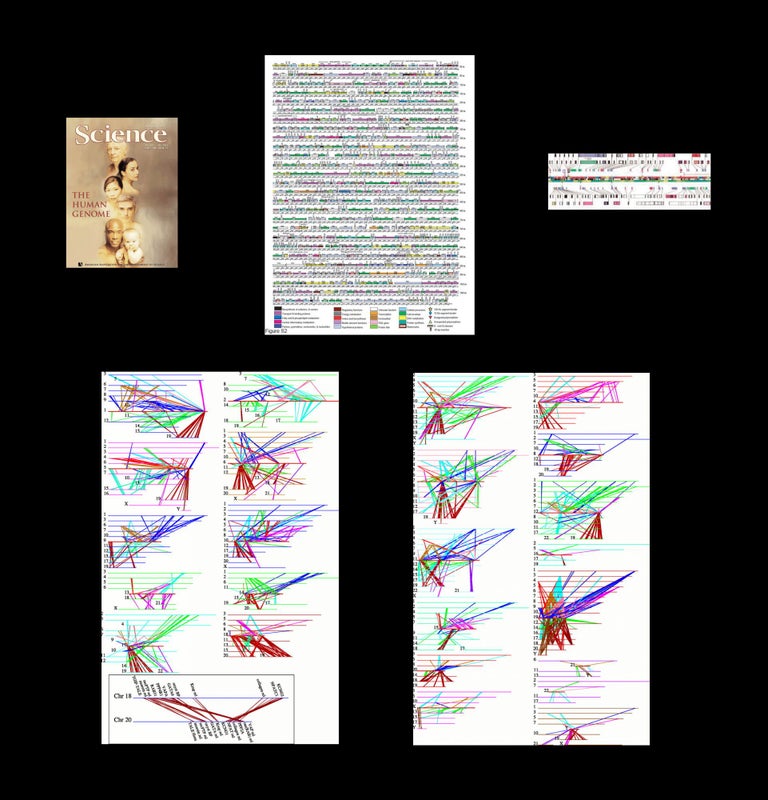The Sequence of the Human Genome in Science 291, Issue 5507, pp. 1304-1351, February 16, 2001
New York: AAAS, 2001. 1st Edition. FIRST EDITION, JOURNAL ISSUE IN ORIGINAL PRINTED WRAPS OF THE 1st PUBLICATION & ANNOUNCEMENT OF THE 1st COMPLETE GENOME SEQUENCE OF A LIVING SPECIES, inclusive of Venter’s poster of the genome sequence itself. The genome sequence of Haemophilus influenzae used a newly developed technique of whole-genome shotgun sequencing was 1.8 million base pairs in length and required 4 months of sequencing to produce.
The entire issue is dedicated to the announcement of the sequencing of the human genome. Until March 2000, rival teams of scientists who had been working independently to map the complete sequence pooled their data: American-born biochemist-geneticist J. Craig Venter and his colleagues at Celera Genomics and, working with a public consortium (under the direction of the NIH, known as the Human Genome Project (HGP), geneticist Francis Sellers. Together, an amalgam of public and private researchers was able to successfully map and sequence the human genome.
This issue includes initial analyses of the genome and genomic data, as well as in-depth discussions of the implications of the results both at publication and into the future. Included with the issue is Venter’s large folded poster depicting “the human genome, chromosome after chromosome, its major features color-coded and described. Black tick marks show the coding regions along orange, blue, pink, and purple genes, the colors reflecting the function of the corresponding proteins. All told, some 2.9 billion bases of the genome are represented. For example, while it took geneticists 7 years to find the gene involved in cystic fibrosis, here it can be located in few seconds in the last third of chromosome; here the genes implicated in hereditary breast cancer (BRCA1) can be found just as quickly on chromosome 17… 15 months prior to publication, the positions of barely 10% were known; at publication 90% were represented with varying degrees of certainty” (Pennisi, The Human Genome, Science 291, 5507, 2001).
Each team of scientists employed a different technique. The NIH’s Human Genome Project, believed it too expensive to sequence the complete human genome. Instead, they “adopted a 'shortcut', which was to look just at sites on the genome where many people have a variant DNA unit” (Chan, Biostatistics for Human Genetic Epidemiology, 9-10). Essentially, they “shredded the DNA of the whole genome into overlapping pieces, sequenced the pieces, and then reassembled them with powerful computers and sophisticated algorithms” (Diamond, Openness to Creative Destruction, 25). “This is known as the 'hierarchical shotgun' approach, because the genome is first broken into relatively large chunks, which are then mapped to chromosomes before being selected for sequencing” (Chan).
The technique of sequencing the complete human genome that the HGP had vetoed as too expensive and “logically impossible,” Venter and Celera then used and made work (Diamond). Venter’s team used a clone-by-clone technique by generating “a massive shotgun library derived from its own DNA sequence data combined with the "shredded" Human Genome Project DNA sequence data, which together corresponded to a total of 43.32 million sequence reads (Venter et al., 2001). Celera then used computational methods and sophisticated algorithms to identify overlapping DNA sequences and to reconstruct the human genome.
And it was only the beginning… that “genome sequence was only 1.8 million base pairs in length and required 4 months of sequencing to produce. Five years later, as a result of dramatic changes in automation and massively parallel DNA sequencing, it was possible to sequence the human genome at 3 billion base pairs in only 9 months, a >1000-fold improvement” (Venter, The Human Genome at 10, Science 33, 2011, pp. 546). Item #1269
CONDITION & DETAILS: New York: AAAS. Original pictorial wraps. 4to. Both are bright and exceptionally clean within. Pristine condition in every way. Venter’s genome poster is also in perfect condition. Fine.
Price: $275.00

